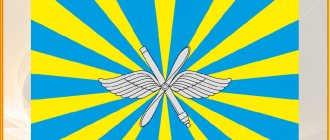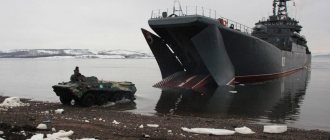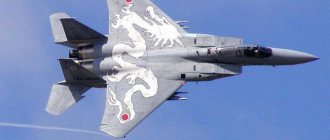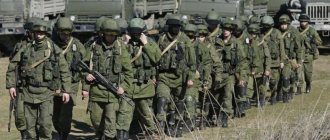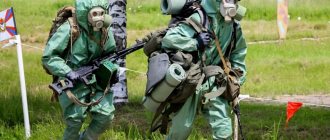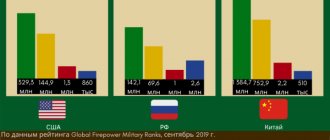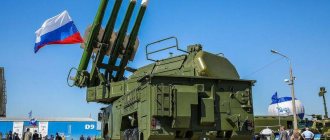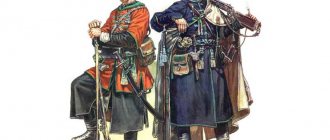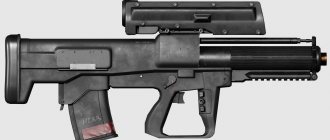Motorized rifle troops (MSV) are a branch of the ground forces, which is infantry equipped with means of transportation and fire support. Nowadays, motorized rifle troops are the basis of most armies in the world. Their main task is to conduct large-scale ground operations, both independently and in coordination with other branches of the military. In the West, MSVs are often called “mechanized infantry.”
Motorized riflemen can fight in any terrain, day or night and in any weather, on foot or in their combat vehicles. The main advantages of MSVs are their mobility, maneuverability and great versatility.
Motorized rifle units include artillery, tank and anti-aircraft units, as well as a number of special military formations (for example, engineering units, chemical and radiation protection units). Modern infantry is armed with tactical missile systems capable of using nuclear weapons.
In Russian modern history, motorized rifle troops have repeatedly taken part in hostilities. In particular, the 201st Motorized Rifle Division of the Russian Army fought on the side of the legitimate government of Tajikistan in the civil conflict of the early 90s. Russian motorized riflemen were engaged in protecting the state border of this country. The main brunt of both Chechen campaigns fell on the shoulders of motorized riflemen. Russian motorized rifle troops also took part in the war with Georgia in 2008.
The Day of Motorized Rifle Troops of the Russian Federation is celebrated on August 19. The unofficial flag of the motorized rifle troops is a black cloth on which crossed Kalashnikov assault rifles are framed by laurel wreaths. The emblem is complemented by two St. George ribbons and the MSV motto: “Mobility and maneuverability.” The flag of the motorized rifle troops completely replicates the sleeve patch of the motorized rifle troops.
The MSV is the modern embodiment of the infantry, the oldest branch of the military, on whose shoulders from time immemorial the main burdens of war fell. Hoplites, Roman legionnaires, landsknechts, the “grey-overcoated bastard” of the First World War - they have always formed the backbone of any army, because the war ends exactly at the point on which the foot of the infantryman sets foot.
From the history of motorized rifle troops
The widespread use of automobiles began during the First World War. This significantly increased the mobility and maneuverability of the infantry. In 1916, a new era began - the first tanks were created in Great Britain. And at the end of the First World War, the British developed a transport tank - the prototype of a modern armored personnel carrier on which infantry could move during battle.
After the end of the First World War, the world's advanced armies embarked on the path of mechanization and motorization. In addition to tanks and trucks, various types of armored personnel carriers, armored vehicles and tractors were developed.
In the USSR in 1939, a new type of unit appeared - a motorized division. It was planned that the movement of personnel of such units would occur using vehicles. However, Soviet industry was not yet ready to provide the Red Army with a sufficient number of high-quality vehicles. During the war, the issue of mobility of the Red Army ground formations was mainly resolved through lend-lease equipment - American armored personnel carriers and excellent Studebaker trucks.
Great attention was paid to the motorization of ground forces in Nazi Germany. The Germans carefully studied the experience of using motorized vehicles during the First World War and came to the conclusion that increasing the mobility of ground forces is one of the main components of success, both in offense and defense. Large-scale infantry motorization made a significant contribution to the success of the new German concept of warfare - blitzkrieg tactics.
The German tank divisions - the spearhead of the driving forces of the blitzkrieg - included several motorized rifle regiments armed with Sd.Kfz armored personnel carriers. 251 and had a significant number of vehicles.
Gradually, ordinary German infantry divisions were saturated with armored personnel carriers and vehicles, after which they received the status of motorized and motorized grenadier divisions.
How many people are in a platoon of soldiers?
A platoon is a military unit, most often consisting of 2-4 sections, part of a company or battalion (in some cases it exists independently). Usually there are from 9-12 to 45-50 people in a platoon, depending on the type of troops, country or purpose of the platoon. Platoon commanders are sergeants, warrant officers, junior lieutenants, lieutenants or senior lieutenants, that is, they can be either an officer or a non-commissioned officer.
Soviet motorized rifle brigades
Motorization and mechanization of the ground forces became one of the main directions of modernization of the Soviet army after the end of the war. Soviet generals realized the need to increase the mobility of infantry formations. In June 1945, the State Defense Committee issued a decree on the replenishment of armored and mechanized formations of the Red Army. However, the issue of saturating the ground forces with vehicles and armored personnel carriers will only be completely resolved by 1957. As a result, 1958 was the year of the appearance of Soviet motorized rifle troops.
Soviet motorized rifles were the first in the world to adopt a new type of armored vehicles - infantry fighting vehicles. These versatile vehicles could not only transport infantry, but also effectively support them in battle. The BMP-1 began to enter combat units of the Soviet army in 1966. Later, the Soviet concept of using infantry fighting vehicles was picked up by most Western countries. It should be noted that almost all armored vehicles of the USSR motorized rifle troops could independently overcome water obstacles and were well protected from weapons of mass destruction.
In the USSR, motorized rifle troops were the most numerous in the armed forces; we can say that the MRF became the basis of the Soviet army. At the end of the 80s, there were more than 150 motorized rifle divisions. In addition, each tank division included one or two motorized rifle regiments.
A typical Soviet motorized rifle division (MSD) of the late 1980s consisted of three motorized rifle regiments, in addition to one tank regiment, an anti-aircraft missile and artillery regiment, a rocket artillery battalion, and an anti-tank gun battalion. The MSD also included support units.
Motorized rifle regiments of the Soviet army were of two types: armed with armored personnel carriers or infantry fighting vehicles. Typically, the MSD included two regiments with armored personnel carriers and one with infantry fighting vehicles. It should be noted that the regiments armed with infantry fighting vehicles were planned to be used in the first echelon of the attack.
There were also separate motorized rifle brigades armed exclusively with infantry fighting vehicles.
At the end of the 80s, the air defense of motorized rifle regiments was strengthened - the anti-aircraft battery was expanded to a division.
It should be noted that the USSR had deployed motorized rifle divisions only abroad (late 80s): in Afghanistan, Germany, Eastern Europe. These MSDs included from 10 to 15 thousand military personnel. On the territory of the USSR, the number of divisions was usually about 1,800 people.
The training of officers for motorized rifle troops was carried out by several higher military educational institutions: Military Academy named after. Frunze and nine combined arms military schools.
In the US Army
Platoon - a combat unit in the Army or Marine Corps, consisting of 2 or more detachments, sections and patrols. They are divided into weapons and support platoons according to the division structure. The personnel consists of 39 soldiers or 43 marines.
Photo: Navy SEALs. Source: mercinews.com
By type of troops there are motorized infantry, tank, sniper, transport, anti-tank, lightly armored, mortar, reconnaissance, etc. To perform tactical tasks they can be formed in numbers from 18 (sniper) to 69 people (mortar). The unit is commanded by a lieutenant.
For reference . More than 10,000 American military personnel are Russian by nationality. One of the purposes of serving in the United States is free higher education.
Continuing the topic, a short video: “Special report “Platoon”: how the experimental officer training program is going”:
The material was edited by reserve major Alexander Andreev
Author: Roman Zorin. March 19, 2022.
Motorized rifle troops of the Russian Federation
As in Soviet times, the motorized rifle troops of the Russian Federation are the basis of the ground forces of the modern army. Since 2000, they have gradually switched to the brigade principle of formation.
It is believed that motorized rifle brigades (compared to divisions) are a more flexible and versatile tool for solving various combat missions. According to Russian strategists, the brigade structure of motorized rifle troops is more suitable to the realities of the present time. It is believed that the threat of a large-scale war is a thing of the past, and brigades are much better suited for local conflicts than numerous and cumbersome divisions. Brigades can conduct combat operations in any terrain and climate conditions, using both conventional weapons and weapons of mass destruction.
In recent years, there has been more and more talk about a partial return to the divisional structure of motorized rifle troops. The Taman division has already been recreated, motorized rifle divisions will appear in the Far East, Tajikistan and the western part of the country.
About combat use
Judging by the reviews, the 34th Motorized Rifle Mountain Brigade was deployed during the Olympic Games in Sochi. Also, soldiers of the 34th Motorized Rifle Brigade (g) took part in the armed conflict in South Ossetia. In history this event is known as the Five Day War. Officers and soldiers carried out several successful military operations in the Marukh and Klukhor passes. After a sharp escalation of the Georgian-Ossetian conflict, namely, a massive shelling by Georgia of the capital of South Ossetia, Russian troops were brought into the region to support the South Ossetian and Abkhazian armed formations. Within a few days, the Georgian army was driven out of the Kodori Gorge. As a result, it was possible to temporarily occupy the areas of Georgia adjacent to the conflict zone. After the signing of the peace plan, South Ossetia and Abkhazia became independent states.
Motorized rifle battalion
The motorized rifle battalion (MSB) is the main combined arms tactical unit in the MRB. Its staffing composition has remained virtually unchanged since the times of the USSR - in the Russian army, changes affected units of a higher order - divisions were replaced by brigades united in districts.
The SME includes three motorized rifle companies, one mortar battery, and three platoons: anti-tank, grenade launcher and anti-aircraft missile. In addition, the SME includes support units (communications platoon, medical center).
The motorized rifle battalion on armored personnel carriers includes 539 military personnel, 43 armored personnel carriers, 42 vehicles, three Vasilek mortars, six 82-mm mortars, six 9K111 Fagot ATGMs and nine 9K115 Metis ATGMs.
The infantry fighting vehicle motorized rifle battalion includes 462 military personnel, 39 BMP-2 units (including 2 BMP-2K), 42 vehicles, three Vasilek automatic mortars, six 82-mm mortars, six AGS-17 mounted grenade launchers.
Further development
In 2003, the Russian military leadership decided to use Army No. 58 as the basis for military unit No. 01485. In 2005, military camps began to be built near Makhachkala. The very next year, the village of Storozhevaya functioned as an independent military unit. At the end of June 2006, President of the Russian Federation Vladimir Putin issued a decree on the formation of the 34th Motorized Rifle Brigade (g). By the beginning of December 2007, the 34th mountain brigade was finally completed. The construction of the garrison and military camp in the place where it is located today was completed by 2008.
How to get there?
Judging by the reviews of eyewitnesses, it is most convenient to come to the military unit from Cherkessk or Zelenchuk. A bus leaves from Cherkessk to the village of Storozhevoy at 11 a.m., and from Zelenchuk at 9:00. In this case, you will have to walk another 10 km from the village to military unit No. 01485.
To avoid walking from Novomyssk, many hire a private taxi or drive their own transport. You can also catch a ride. You can stay at a hotel in the village of Storozhevoy. If the commandant allows, then you can temporarily move into the dormitory for officers. Some rent rooms in the private sector in Cherkessk or in another nearby locality, such as Arkhyz or Khabez.
About weapons
The 34th Motorized Rifle Brigade (g) has the following armored vehicles:
- Soviet amphibious armored personnel carriers MT-6LB. The brigade currently has 7 units in service.
- Soviet-made floating armored personnel carriers MT-LBVMK in the amount of 7 pieces. and MT-LBu (8 units).
- Transportable mortars 2B11 (9 pcs.).
- 152-mm howitzers 2S3 (9 guns).
- KAM-AZ 5350 machines (8 pcs.).
- Armored personnel carriers manufactured in 1980 (8 units).
- Engineering tanks IMR2 M2 (8 units).
- Command and staff vehicles. The brigade has 8 such vehicles.
Recommendations for parents
Anyone who wishes to visit their son can do so during the oath. In other cases, your visits to the military unit will first have to be coordinated with the military unit command. You can also give a parcel and a letter to a soldier. To do this, you should indicate the address of the unit: Karachay-Cherkess Republic, Zelenchuksky district, Storozhevaya village No. 2, military unit No. 01485, index 369162. Next you need to indicate the platoon and company where the soldier is serving, as well as the full name of the recipient. The post office is located on Gornaya Street, 15. The post office is open from 9 a.m. to 6 p.m. Days off are Sunday and Monday. Lunch break - from 2 to 4 pm.

